


According to the Palestinians, the girl, Hadil Ghraben, was at home with her brothers and sisters when the shell landed inside the house. The child was killed on the spot and all her siblings and other family members who were there at the time were injured by shrapnel.

Children evacuated from Beit Lahiya house (Photo: Reuters)
The children's mother who was eight-month pregnant was wounded in the head, and physicians said she is in critical condition, but have yet to establish whether the fetus was in danger too. The rest of the family members sustained moderate wounds. The family's neighbors reported that the house itself was completely destroyed.
According to reports, 10 shells hit the Ghraben family's house. Palestinians said that the IDF continued its artillery attacks and strikes from the sea on targets in the southern and northern Strip Monday.
Throughout Sunday and Monday, Palestinian sources reported that some 30 people were injured in IDF bombardments on the Strip.
IDF: Terrorists use civilians as human shields
IDF sources said that the family's house was located at an area from which terror organizations regularly launch Qassams at Israel. Army officials stated that an initial inquiry into the incident indicated that the IDF shelled the area, but that they were still investigating the mater.
"We regret any harm caused to civilians, this is not our intention, but it is the terror groups that force us to fire at populated areas," an army source explained.
However, a senior IDF officer told Ynet that hurting children and the publication of pictures from such strikes undermine the legitimacy Israel enjoys in its war on Qassams.
"That's exactly the dilemma. If we don't expand our shooting range and fire at all the places terrorists are at, this will impede our efforts to eliminate rocket attacks. On the other hand, we have no intention to kill kids. The terrorists are cynically exploiting the children," he said.
IDF sources added that rockets were fired throughout the day from the area targeted in the army's strike Monday afternoon. "The residents know that terrorists operate from there and that the IDF retaliates. We distributed leaflets to locals in which we explained these are danger zones."
The officials also stated that the terrorists intentionally fire Qassams from behind houses, in a bid to transform the buildings and their residents into human shields.
"The populated area that was required to be evacuated is very small. The leaflets we distributed were not for show, and were intended to warn the Palestinians from falling victim to the terror cells," an army officer explained.
The B'Tselem human rights group said that Israel bears the legal responsibility for the girl's death. "The child's killing is the inevitable result of narrowing the safety range of artillery fire from civilians' houses," the group said in a statement.
Civilians in the line of fire
In IDF bombardments of Gaza last week, the army fired 1000 shells at the Strip in response to Qassam attacks at the western Negev.
In the framework of the recent escalation in the war between Palestinian rocket launchers and the IDF, the Palestinian civilians residing in the line of fire seem to have been forgotten. These people have over the last weeks sustained shrapnel injuries and damages to their houses.
The IDF said in response that "there is no intention to target populated centers or civilians, and we lament any such hit."
The areas in the northern Strip have long ago ceased to function as residential regions. Caught between the Palestinian gunmen and the Israeli shells, residents describe a sense of living in constant fear, "like being stranded in a shooting range."
"Life in recent weeks is unnatural. It's like a war movie, a horror flick that gets more terrifying by the second," Osama al-Bidi, 27, a Beit Lahiya resident said.
"Wherever you go you see houses full of holes and shrapnel, damaged houses. Some of the houses are deserted because dozens of families left. How can these people go back to their houses in this situation?" he asked.
Hanan Greenberg contributed to the report















